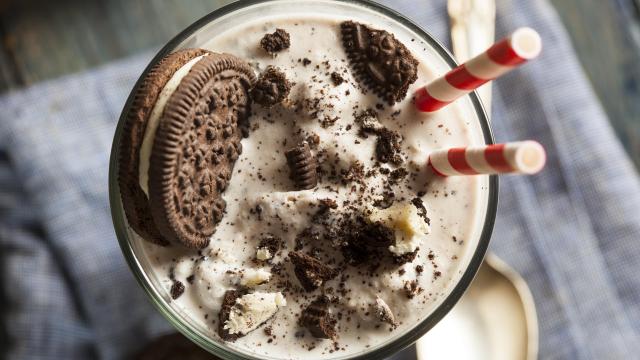Milkshakes and concretes are two frozen treats that look awfully similar. As Memorial day approaches and the need to scarf frozen desserts skyrockets, it’s a good time to learn the difference between these two creamy treats. Both are delicious, but one is easier to duplicate at home than the other.
What makes a milkshake?
A milkshake starts with ice cream, or an ice cream-like frozen dessert. This is a simple but important distinction, as you’ll see later with concretes. A small amount of liquid, usually milk, is added to the ice cream and the whole mixture gets rapidly agitated with the stick of a milkshake machine. The milkshake machine is designed to keep the dessert as cold as possible, with the engine positioned away from the ice cream, and a blending stick that has one or two blunt discs that take care of the mixing. After this quick mix, you get a thick, sweet, drinkable version of your favourite ice cream. It’s still cold and frosty, but the little bit of liquid and agitation breaks the ice cream up just enough to make it a drink.
Milkshakes are a breeze to make at home, even if you don’t have a milkshake machine. You can use a standard blender or even an immersion blender to make this summer-worthy treat. (Actually, an immersion blender is preferable, as the motor is positioned much like that of a milkshake machine.) Simply add half a pint of ice cream to a blender jar with 1/4-1/3 cup of milk. The less milk, the thicker the milkshake, but you need something to get the blender blades to catch the ice cream. Blend for about a minute. Milkshakes don’t usually have chunky mix-ins, so they can be enjoyed through a straw, but if your ice cream contains brownie bits or peanut butter cups, go right ahead and use it. Those add-ins have been sitting in the mixture for as long as it’s been on the grocery store shelf, so they’ve softened a bit. The blender will pulverize the inclusions, and you’ll still be able to drink them through a straw, along with the rest of the ice cream. Or if the bits are too big, forget the straw. It’s your house.
Consider the concrete
A concrete has some distinct differences from a milkshake, specifically, the custard base mixture, the final texture, and the mix-ins. Technically, the common ice cream you buy at the store and use in a regular milkshake is made from a custard base. A custard is dairy thickened with the help of heated whole eggs or egg yolks, and a concrete uses a custard base that has a higher ratio of egg yolks in the recipe than the average ice cream.
More yolks in the custard make a thicker, richer, creamier product that churns and freezes with a tighter texture than regular ice cream. The creamy custard is churned and frozen the same way regular ice cream is. The frozen custard is then ready to eat, but to make it a concrete, you must press delicious things into it. Instead of adding in a liquid to make the mixture drinkable, no liquid is added, and big hunks of other things, like doughnuts or cookies, are smashed in. On a menu, the mix-ins listed usually follow the base. It’s not doughnut-flavored, there are actual doughnuts in it. The concrete will be thick enough to stand up, and a straw will not do. Only a spoon can help you take it down.
Making a concrete at home should be easy; after all, you don’t need a blender. The big problem is that commercially packaged frozen custard is a rarity in grocery stores (at least where I live), so you have to make the custard from scratch. Now you do need specialty equipment, specifically an ice cream churner. Luckily, custard recipes are relatively straight forward, with the majority of the time being inactive with churning or freezing. Once your custard is frozen somewhat solid, scoop the custard into a bowl and add broken bits of anything you like. Try crumbled doughnuts, cookies, chopped Twix bars, goat cheese, maple bacon, or add chocolate sauce to it.
Then there’s always the final option. Make a faux-concrete. Buy your favourite ice cream, let it soften on the counter for 10 minutes, and mix crumbled desserts into it. Summer has arrived.

Leave a Reply
You must be logged in to post a comment.